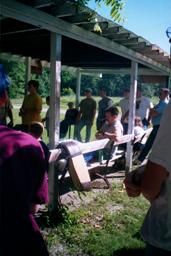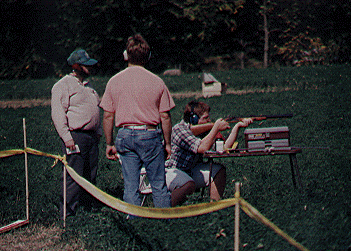|
 The creation of 4-H Shooting Sports programs rest in the shooting and hunter education communties, the arms and annunition industry and 4-H itself. Each oranization entered the cooperative venture of building the program with a different set of objectives. Later those ovjectives merged into a cohesive program structure. The creation of 4-H Shooting Sports programs rest in the shooting and hunter education communties, the arms and annunition industry and 4-H itself. Each oranization entered the cooperative venture of building the program with a different set of objectives. Later those ovjectives merged into a cohesive program structure.
Shooting and hunter education organizations shared a concern about recruitment and development. Although shooting
is almost as popular as track and field in international sporting events, competitive shooters were relatively rare
and aging. Recruitment invovled shooting organizations reaching out to poeple who were already interested in shooting sports.
Like many other organizations, including 4-H, the recruitment efforts were directed at the easily reached audience of shooters who had a shooting tradition.
Hunter educators were concerned about teachig essentioal skills to produce safe and ethical hunters. The need was particularly acute for poeple coming from non-hunting and non-shootig backgrounds. Attacks on hunting made both recruitment and effective preparation more critical. They also outlined a need to broaden the base of understanding about hunting and other types of consumptive wildlife recreation or enterprise.
Industry had a strong, economic incentive. Sales of shooting equipment, ammunition and accessories were their livelihood. Economic stresses, antigun activities and declining participation rates in shooting and hunting were warning signs of economic hardship. Industry also faced a declining pool of skilled professionals in specialized areas of manufacture. Engravers, stock makers and other skilled artists or gunsmiths were in demand but rare and hard to find. Introduction of young people to safe and responsible use of shooting equipment and to careers related to shooting was viewed as a long-range solution.
The 4-H program slao faced several problems. Males, both members and volunteers, were under-represented. nationally, participants were nearly 65 precent females. Teens were grossly under-represented with a sharp decline in participation at about the age of 13. In many states the core of the 4-H program, the club, wereexperiencing a continued, long-term decline in membership. Birthright members made up as much as 95 percent of the membership in clubs. The increasing trent toward urbanization, coupled with the "cows and cooking" or "cows, sows and plows" image of 4-H resulted in barriers to participation that could be overcome only with creative programming.
Many youth shooting programs were available, so the subject matter of 4-H Shooting Sports was not unique. Several of the programs laid claim to a youth development foundation. Most of them used a volunteer corps to present the program to young people. Afew of them even tried to link shooting toother areas of concern The 4-H Shooting Sports program tried to combine the best of all of these programs while keeping a relationship with the existing natural resources, safety or outdoor recreation programs. The materials and training programs emphasized young people and their life skills as the product of the program while using tested techniques and positive reinforcement to develop fundamentally sound shooters. Strong and continuing recruitment of volunteers, intensive volunteer equipping and management, minimal commitent of professional staff time and attrativeness to males and older teens have been and continue to be key elements in sucessful 4-H shoting programs.
The cooperation with other organizations and agencies, innovation with 4-H, skills development and recruitment of identified audiences have been powerful. Where the program goes from here depends upon the orientation and commitment of the leaders and coaches who drive it.
Ideal Youth Programs,
CLICK HERE.
 Defining any ideal youth program involves risk. Every person interested in young people has a point of view and a set of biases. When a committee defines and structures the program, often too many elements are included because of these opinions. A simple definiton may be better. Defining any ideal youth program involves risk. Every person interested in young people has a point of view and a set of biases. When a committee defines and structures the program, often too many elements are included because of these opinions. A simple definiton may be better.
Ideal youth programs seem to share several elements. These programs are attractive to kids,
parents and other volunters. The leaders are well-prepared, positive and understand the objectives of the program. They guide program direction, involving the participating upung people in determining the exact nature and content. All participants strive to expand their interests, skills and competencies. Youth development and the growth of their coping. competency and contributory onformative and positive activities valued by the young people. Parents and older youth are actively involved and given increasingly responsible duties. Relationships are more important than skills, achievement or awards; and those who lead and guide the program ensure that the priorties remain in order. Finally, the groups are kept small with a high ratio of leaders or coaches to young people to facilitate building relationships, mentoring and role modeling.
What is Shooting Sports?
Adpatation from 4-H Shooting Sports Instructor Manuals
|
|  |
Shooting Sports is an active program, attractive to youth and adult audiences. The curriculum is designed to assist young poeple in personal development, establish a personal environmental ethic, and exlore lifelong vocational and avocation activities. The program uses experiental learning and positive interactions with youth and adult role models to hepl young people develop self-concept, self assurance, and a positive self-image. |
|  |
The content provides a framework for lifetime participation in recreation, hobbies, and careers related to shooting sports and wildlife. Core concepts stress safety, ethical develpoment, personal responsiility, and lifetime recreational skills. |
|  |
The program promotes responsibility, decision making, and identifying realsistic, personal goals. Participants may choose to compete at a level appropriate for their abilities or pursue other objectives. participants have shown high achievement in the field, shop or classroom, and on the traget range, but personal development for young people and leaders is the real objective. The program strives to make "every kid a winner," and to "make the best better." |
|  |
Like other 4-H projects, Shooting Sports has a subject matter base. It has strong links to natural resoures, wildlife, outdoor recreation, and safety. The content is drawn from sports medicine, psychology, education, biological and physical sciences, engineering, mathematics technooly, as well as American traditons, folklore, and history.
|
|  |
The proportion of volunteers and participant new to 4-H is as high as 80 percent in Shooting Sports. Links with other 4-H programs allow the program to introduce the wide array of activities and leaning experiences 4-H has to offer. The program promotes positive interaction between young people and concerned, interested, and well-prepared adults not being reached by other programs. |
|  |
The content contunies to grow, and its scope is limited only by the availability of leaders and the imagination of participants. The program is flexible and adaptable to nearly any local audience-rural or urban. Equipment and facilities are also flexible, and numerous funding alternatives are available. its major disciplines include archery, hunting and wildlife, mussleloading, pistol, riles and shotgun. The basic program leads into more advance activities. |

|
